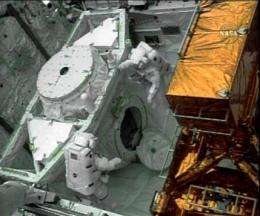Astronauts step out on 1st spacewalk to fix Hubble (Update)

(AP) -- A pair of spacewalking astronauts stepped outside Thursday to begin demanding repair work on the Hubble Space Telescope, a job made all the more dangerous because of the high, debris-ridden orbit.
John Grunsfeld and Andrew Feustel emerged from space shuttle Atlantis and quickly got started on their first job, a camera swap. The telescope - the size of a school bus - loomed over them.
"Ah, this is fantastic," Grunsfeld said as he floated out.
"Woo-hoo," Feustel shouted.
It was the first of five high-risk spacewalks to fix Hubble's broken parts, install higher-tech science instruments and make the observatory more powerful than ever.
Atlantis and its crew are traveling in an especially high orbit, 350 miles above Earth, that is littered with pieces of smashed satellites. A 4-inch piece of space junk passed within a couple miles of the shuttle Wednesday night, just hours after the shuttle grabbed Hubble. Even something that small could cause big damage.
Grunsfeld and Feustel first needed to remove a 15-year-old camera and then put in an updated model. Each is the size of a baby grand piano and awkward to handle. Also on their to-do list: replacing a computer data unit that broke down last fall, and installing a docking ring so a robotic craft can guide the telescope into the Pacific years from now.
The new wide-field and planetary camera - worth $132 million - will allow astronomers to peer deeper into the universe, to within 500 million to 600 million years of creation.
The old one coming out was installed in December 1993 during the first Hubble repair mission, to remedy the telescope's blurred vision. It had corrective lenses already in place and, because of the astounding images it captured, quickly became known as the camera that saved Hubble. It's also been dubbed the people's telescope because its cosmic pictures seem to turn up everywhere.
The camera - which has taken more than 135,000 observations - is destined for the Smithsonian Institution.
Grunsfeld, the chief repairman with two previous Hubble missions under his work belt, took the lead on the camera replacement as well as the work to install a new science data-handling device.
Hubble's original data handler, which was launched with the telescope 19 years ago, failed in September, just two weeks before Atlantis was supposed to take off on this fifth and final servicing mission. The breakdown caused all picture-taking to cease and prompted NASA to delay the shuttle flight by seven months.
Flight controllers managed to get the telescope working again, but NASA decided to replace the faulty computer unit. The goal is to keep Hubble running for another five to 10 years.
Astronaut Michael Massimino, who will venture out Friday, took a moment to send a Twitter update from Atlantis on Thursday.
"Rendezvous and grapple were great, getting ready for our first spacewalk," he typed.
Massimino, a.k.a. Astro-Mike, has been sending tweets since a month before liftoff.
---
On the Net:
NASA: http://www.nasa.gov/mission-pages/hubble/main/index.html
©2009 The Associated Press. All rights reserved. This material may not be published, broadcast, rewritten or redistributed.




















